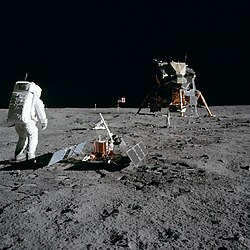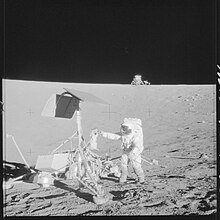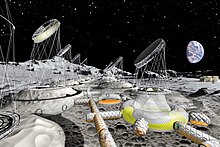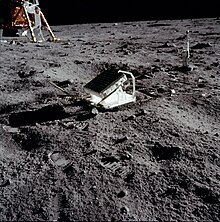|
Moonbase A moonbase (or lunar base) is a human outpost on or below the surface of the Moon.[1] More than a mere site of activity or temporary camp, moonbases are extraterrestrial bases, supporting robotic or human activity, by providing surface infrastructure. Missions to the Moon have realized single-mission bases, (Tranquility Base being the first), as well as some small permanent infrastructure like lunar laser ranging installations. Plans for establishing moonbases, with surface or sub-surface research stations, have been proposed and are actively pursued nationally and increasingly internationally. As of 2024, the two most advanced projects to set up moonbases have been pursued multilaterally as part of the US-led Artemis program, with its planned Artemis Base Camp and as the China-led International Lunar Research Station.[2] A broader, international infrastructure has been envisioned with the so-called Moon Village concept, and a general international regulatory regime for lunar activity has been called for by the 1979 signed Moon Treaty, and advocated for with an implementation agreement since 2020.[3][4] The surface infrastructure of a base may consist of pre-integrated basic landers, as supporting stations for robotic rovers, or habitation modules for crewed presence, or of surface assembled or in-situ derived and constructed surface stations for sustained lunar habitation.[1] Lunar bases may work with lunar space stations, which in contrast provide infrastructures in lunar orbit supporting activity from there, as with the planned Lunar Gateway of the Artemis program. The development of moonbases into permanent extraterrestrial settlements has been put forward.[1][5] Broader lunar colonization or space colonization in general, particularly as laying territorial claims, which is prohibited by international space law, has been criticized for perpetuating colonialism.[6] Past bases The Apollo Program established the first six temporary bases on the Moon, starting with Tranquility Base (1969). Later robotic missions set up simple robotic temporary bases, leaving their landers behind, starting with Luna 16 (1970). RegulationThe 1967 Outer Space Treaty defines the Moon and all outer space as the "province of all mankind".[8] It restricts the use of the Moon to peaceful purposes, explicitly banning military installations and weapons of mass destruction.[9] A majority of countries are parties of this treaty.[10] The 1979 Moon Agreement was created to elaborate on the Outer Space Treaty, restricting the exploitation of the Moon's resources, particularly by any single nation, leaving it to a yet unspecified international regulatory regime.[11] As of January 2020, the Moon Agreement has been signed and ratified by 18 nations,[12] none of which have human spaceflight capabilities. Current lunar programs are multilateral, with the US-led Artemis program and the China-led International Lunar Research Station. For broader international cooperation and coordination the International Lunar Exploration Working Group (ILEWG), the Moon Village Association (MVA) and more generally the International Space Exploration Coordination Group (ISECG) has been established. Since 2020, countries have joined the U.S. in their Artemis Accords, which are challenging the treaty. The U.S. has furthermore emphasized in a presidential executive order ("Encouraging International Support for the Recovery and Use of Space Resources.") that "the United States does not view outer space as a 'global commons'" and calls the Moon Agreement "a failed attempt at constraining free enterprise."[13][14] With Australia signing and ratifying both the Moon Treaty in 1986 as well as the Artemis Accords in 2020, there has been a discussion if they can be harmonized.[15] In this light an Implementation Agreement for the Moon Treaty has been advocated for, as a way to compensate for the shortcomings of the Moon Treaty and to harmonize it with other laws and agreements such as the Artemis Accords, allowing it to be more widely accepted.[3][4] ConservationIn the face of such increasing commercial and national interest, particularly prospecting territories, U.S. lawmakers have introduced in late 2020 specific regulation for the conservation of historic landing sites[16] and interest groups have argued for making such sites World Heritage Sites[17] and zones of scientific value protected zones, all of which add to the legal availability and territorialization of the Moon.[18] Moon Village concept The Moon Village concept was presented in 2015.[19] "Village" in this context refers to international public and private investors, scientists, engineers, universities, and businessmen coming together to discuss interests and capabilities to build and share infrastructure on the Moon and in cislunar space for a variety of purposes. It is neither an ESA project nor a program, but being organized, loosely, by a nonprofit organization seeking to give a platform for an open international architecture and collaboration. In other words, Moon Village seeks to create a vision where both international cooperation and the commercialization of space can thrive.[20][21][22]
The open nature of the concept would encompass any kind of lunar activities, whether robotic or astronauts, 3D printed habitats,[24] refueling stations, relay orbiters, astronomy, exploiting resources, or even tourism. The idea is to achieve at least some degree of coordination and exploitation of potential synergies and to create a permanent sustainable presence on the surface of the Moon, whether robotic or crewed.[20][21] Jan Wörner, ESA Director General until 2021, described in 2017 the Village simply as "an understanding, not a single facility".[25] This initiative is meant as the first step in coming together as a species and developing the partnerships and "know how" before attempting to do the same on Mars.[20][26] The Director General of ESA, Jan Wörner, states that this vision of synergy can be as inspiring as the International Space Station but on a truly global, international-cooperation basis, and he proposes this approach as a replacement for the orbiting International Space Station, which is due to be decommissioned in 2024.[26][27] China has expressed interest,[28][29] and NASA has also expressed interest in the potential synergy it offers to the proposed Lunar Gateway space station.[22][30] The private aerospace company Blue Origin has also expressed early interest and offered to develop a cargo lander with a 4,500 kg (9,900 lb) capacity of usable payload.[31] Astronaut Buzz Aldrin has long urged his fellow Americans to cooperate with international partners to reach the Moon.[32] The State Space Agency of Ukraine has agreed to uphold MVA principles and cooperate with the MVA to develop "sustainable habitation" of the Moon.[33]  While Wörner is the most famous advocate for Moon Village, it is not an ESA program.[citation needed] Instead, the concept is being organized, loosely, by a nonprofit organization established in November 2017 called the Moon Village Association.[34][35] It is a non-profit organization, registered in Vienna, with the mission to create a global forum for the development of the Moon Village, and to potentially implement a permanent human settlement near the lunar south pole, taking advantage of near-continuous sunlight and nearby deposits of ice and other useful volatiles.[34] In 2018, the Vienna University of Technology got sponsorship from ESA for a design workshop on the topic of the Moon Village. 35 master students have developed hypothetical scenarios for a future Moon village. Interestingly the cooperative concept of the workshop led to a number of new themes, such as multipurpose mobile infrastructure, an astro-scientist training campus on the Moon, an experimental research food lab up to a lunar recycling facility.[36][37]  Chinese conceptIn 2020, China proposed the International Lunar Research Station (ILRS), a somewhat similar proposal to the Moon Village, with Roscosmos and ESA showing interest.[39] The first steps toward establishing the ILRS will be taken through Phase IV of the Chinese Lunar Exploration Program, consisting of Chang'e 6, 7, and 8, as well as the Russian missions, Luna 25, 26, and 27. Long-term robotic and short-term crew missions at the ILRS are expected to begin in the early 2030s.[40] Roscosmos signed a memorandum of understanding on cooperation in the creation of the ILRS with CNSA on March 9, 2021.[41] There is a projected timeline stretching from the 2030s to 2045.[42] The China National Space Administration (CNSA) has commenced the Chang'e program for exploring the Moon to investigate the prospect of lunar mining, specifically for mining isotope helium-3 for use as an energy source on Earth.[43] CNSA director Luan Enjie has stated that humans must learn to leave Earth and "set up a self-sufficient extraterrestrial homeland".[43] On March 9, 2021, Russia and China signed a memorandum of understanding for the joint construction of the International Lunar Research Station (ILRS) around 2035. Russian conceptThe Russian Federal Space Agency (Roscosmos) has planned a fully robotic lunar base called Lunny Poligon. The project was planned for 2020, with an expected completion date of 2037.[needs update] On March 9, 2021, Russia turned to cooperate with China and signed a memorandum of understanding for the joint construction of the International Lunar Research Station (ILRS). United States conceptsThe United States has run several attempts to design and in some cases develop lunar outposts and the needed missions, the first being from 1959, with the upcoming Artemis missions being the most advanced. Current: Artemis Program Soviet Union concepts (defunct)ZvezdaZvezda moonbase (Russian: звезда, "star") was a Soviet plan and project from 1962 to 1974 to construct a crewed moonbase as successor to the N1-L3 crewed lunar expedition program. The project was ordered by the Soviet space chief Korolyov to Barmin's Spetcmash bureau. The project was named DLB Lunar Base in technical specifications and Zvezda in government documents. Unofficially, the project was called Barmingrad (Barmin's city) by its designers. The realization of the project depended on key parts of the N1-L3 program – the N-1 superheavy launcher, all 4 launches of which failed between 1969 and 1972. Zvezda moonbase was canceled with the rest of the Soviet human lunar programs. All crewed Soviet lunar programs, including a Zvezda moonbase, had been classified as top secret and were only published in the glasnost epoch since 1990. Lunar Expeditionary Complex
The LEK Lunar Expeditionary Complex was a lunar expedition and Moon base proposed by Valentin Glushko in 1974 as a Soviet response to the United States' Apollo program and as a successor to the Zvezda moonbase, which was based on the cancelled N1-L3 crewed Moon expedition program. If implemented, it was intended to have been operational by 1980 and used for scientific and engineering research. Energia Lunar Expedition
The Energia Lunar Expedition was a project that was proposed by Soviet engineer Valentin Glushko in 1988 which would’ve aimed to create a lunar base[48] using the Energia rocket. The lunar base was to then be eventually used for mining helium-3 from the lunar surface. Other conceptsIn 1954, science fiction writer Arthur C. Clarke proposed a lunar base of inflatable modules covered in lunar dust for insulation.[49] A spaceship assembled in low Earth orbit would launch to the Moon, and astronauts would set up the igloo-like modules and an inflatable radio mast. Subsequent steps would include the establishment of a larger, permanent dome; an algae-based air purifier; a nuclear reactor for the provision of power; and electromagnetic cannons to launch cargo and fuel to interplanetary vessels in space. In 1959, John S. Rinehart suggested that the safest design would be a structure that could "[float] in a stationary ocean of dust", since there were, at the time this concept was outlined, theories that there could be mile-deep dust oceans on the Moon.[50] The proposed design consisted of a half-cylinder with half-domes at both ends, with a micrometeoroid shield placed above the base. In 1962, John DeNike and Stanley Zahn published their idea of a sub-surface base located at the Sea of Tranquility.[51] This base would house a crew of 21, in modules placed four meters below the surface, which was believed to provide radiation shielding on par with Earth's atmosphere. DeNike and Zahn favored nuclear reactors for energy production, because they were more efficient than solar panels, and would also overcome the problems with the long lunar nights. For the life support system, an algae-based gas exchanger was proposed.[citation needed] As of 2006[update], the Japanese Aerospace Exploration Agency (JAXA) planned a human lunar landing around 2020 that would lead to a crewed lunar base by 2030; however, there was no budget yet for this project.[52][needs update] In 2007, Jim Burke, of the International Space University in France, said people should plan to preserve humanity's culture in the event of a civilization-stopping asteroid impact with Earth. A Lunar Noah's Ark was proposed.[53] Subsequent planning may be taken up by the International Lunar Exploration Working Group (ILEWG).[54][55][56] In 2010, The Moon Capital Competition offered a prize for a design of a lunar habitat intended to be an underground international commercial center capable of supporting a residential staff of 60 people and their families. The Moon Capital is intended to be self-sufficient with respect to food and other material required for life support. Prize money was provided primarily by the Boston Society of Architects, Google Lunar X Prize and The New England Council of the American Institute of Aeronautics and Astronautics.[57] Surface infrastructure Besides temporary infrastructure of lunar missions, some of the permanently placed artificial objects on the Moon have already fulfilled long-term purposes. Since 1969, retroreflectors have been installed on the surface of the Moon and are actively used for lunar laser ranging. In the 2010s, the International Lunar Network consisting of robotic instruments placed around the moon was also proposed. Orbital infrastructureLunar orbital spacecraft have been supporting lunar bases since the use of the Apollo command and service module in lunar orbit. Today an increasing number of lunar satellites provide different services to surface missions and possibly to lunar bases. The current lunar landing Artemis program is to be supported by the scheduled Lunar Gateway.  See also
References
External links
|

